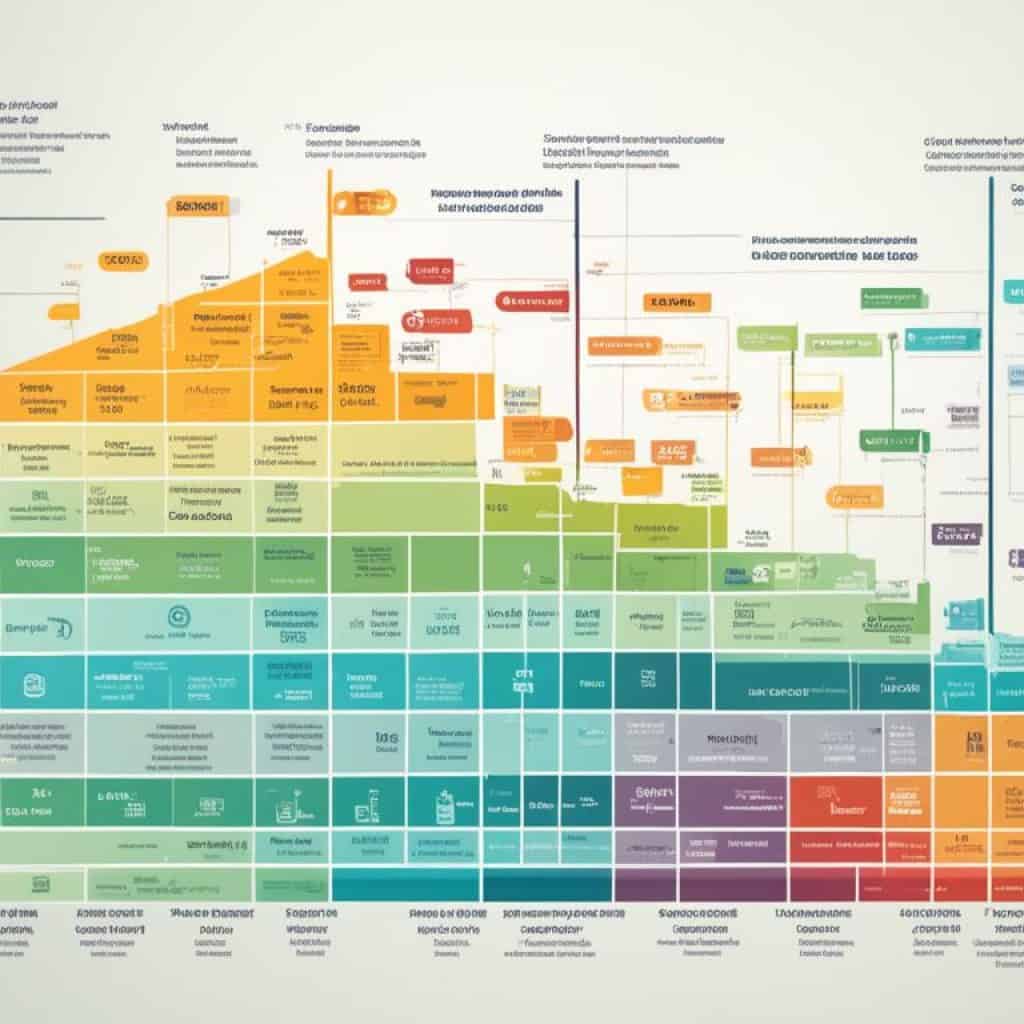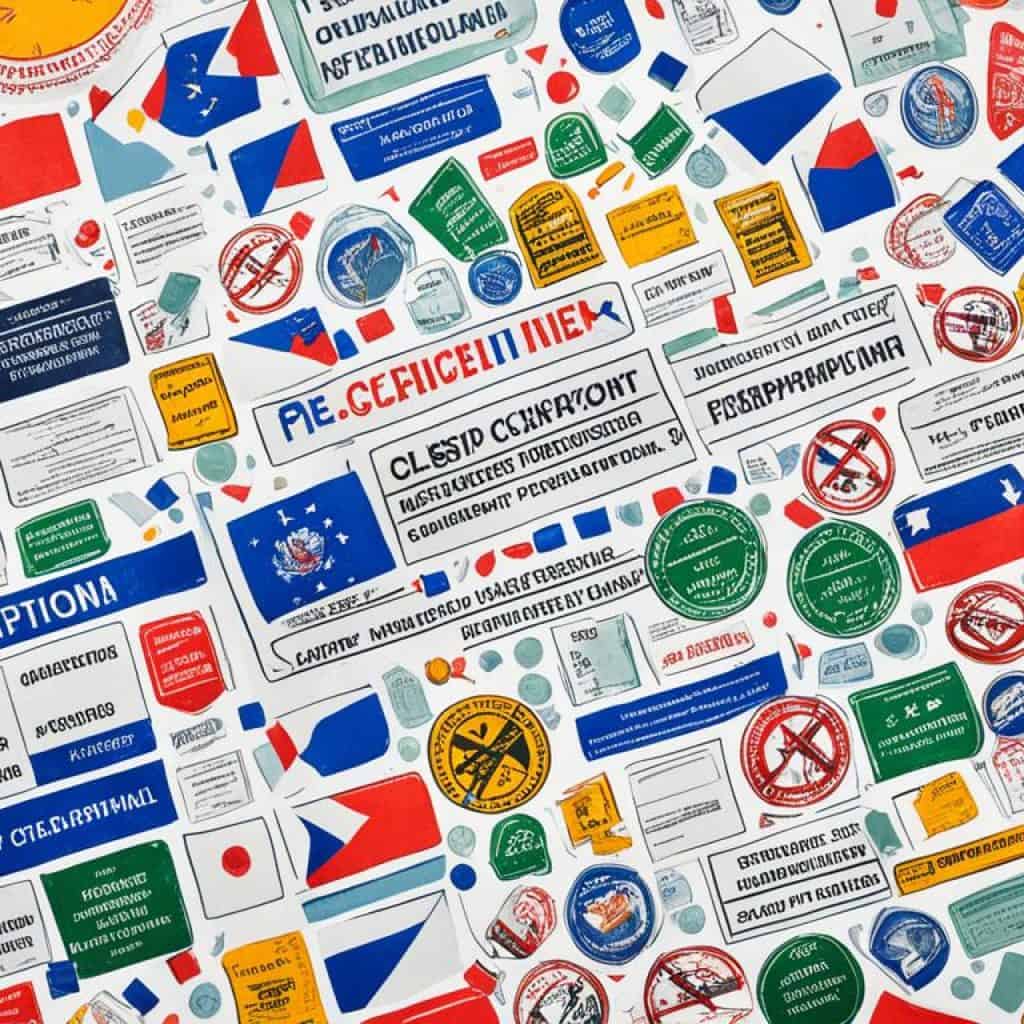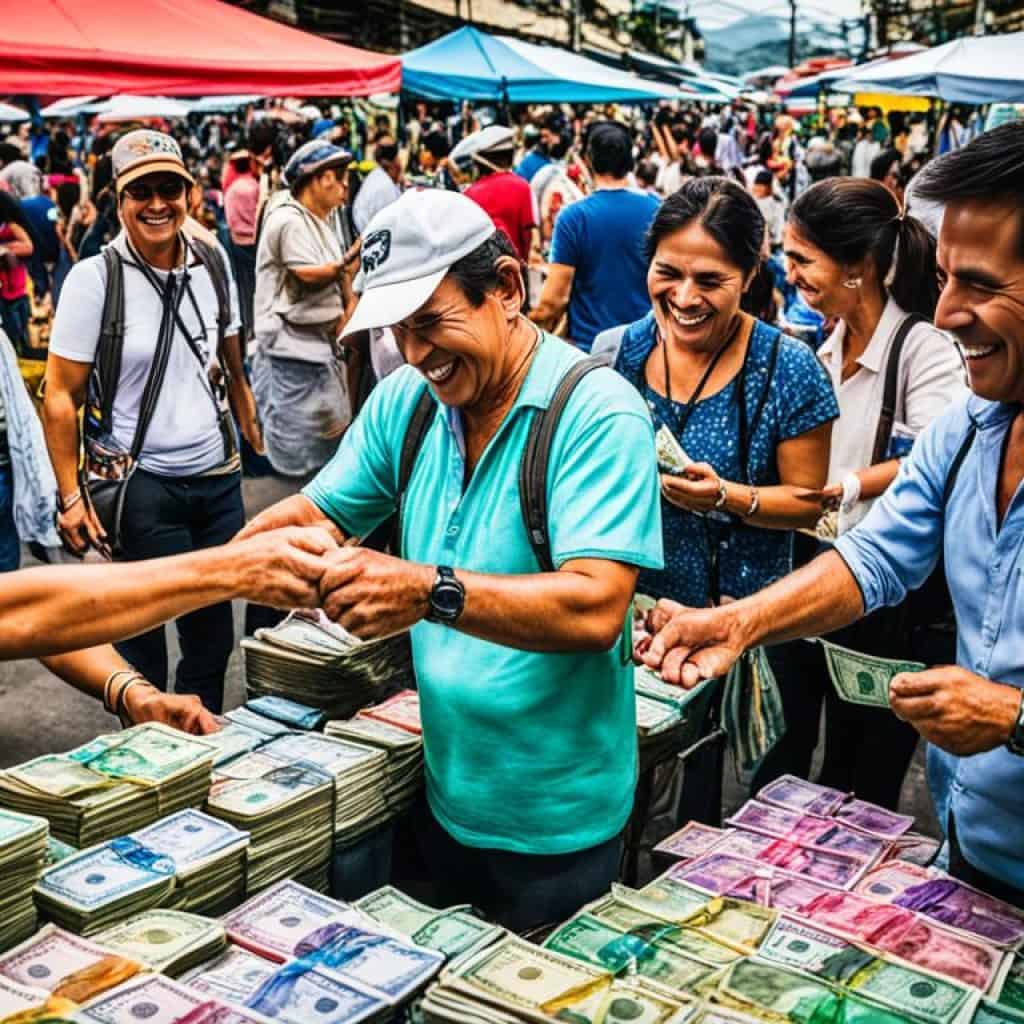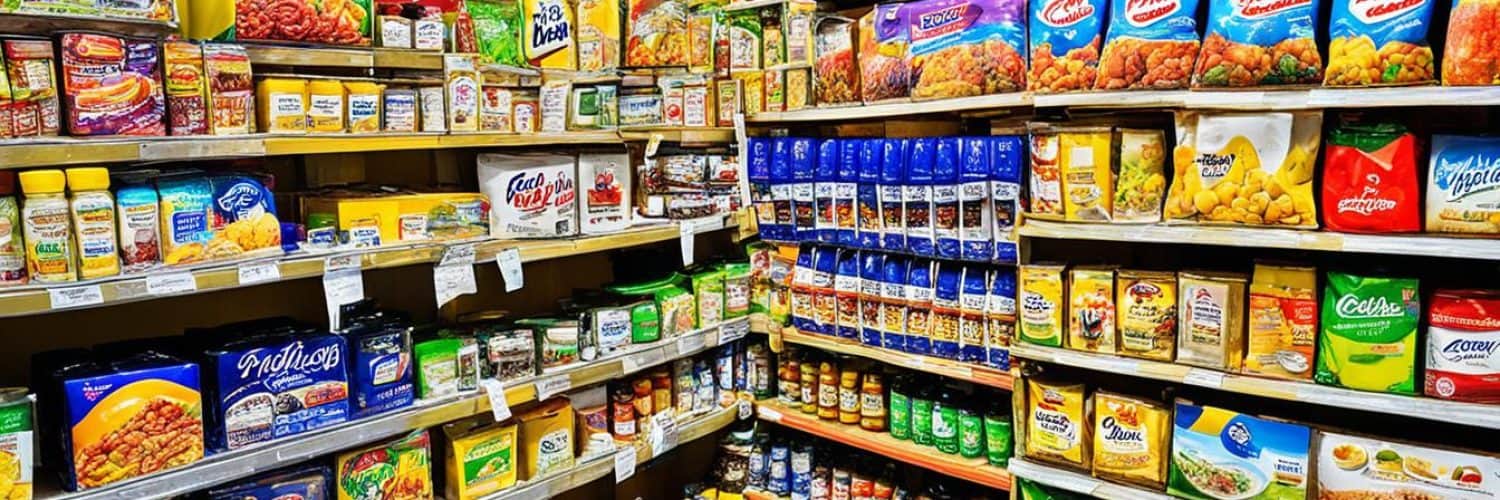Have you ever wondered about the variety of exotic products available in the Philippines? From imported brands to global merchandise, the country is a treasure trove of goods from abroad. But how does the Philippines manage the influx of foreign goods and ensure their compliance with regulations? Let’s dive into the world of imported products in the Philippines and discover the intricacies of bringing overseas goods to the vibrant market of the Philippines.
Key Takeaways:
- The Bureau of Customs, Bureau of Import Services, and the Philippine Department of Agriculture play crucial roles in regulating imports and issuing necessary permits and clearances.
- Imported products are classified as freely importable, regulated, restricted, or prohibited, each requiring different permits and clearances.
- Prohibited goods in the Philippines include used clothing, hazardous waste, toy guns, and explosives.
- The importation of certain dual-use goods requires additional steps, such as obtaining an import permit from the Department of Foreign Affairs and registering with the Bureau of Customs.
- Importing goods into the Philippines is subject to various taxes and fees, including import duties and value-added tax.
Import Classifications and Verification
Imports into the Philippines fall into various classifications, including freely importable, regulated, restricted, or prohibited. Each classification carries its own requirements for permits and clearances.
The Bureau of Import Services, Bureau of Customs’ Customer Assistance and Response Services (BOC-CARES), and the Department of Agriculture provide verification services to determine the import classifications and the status of agricultural products. For information on Minimum Access Volume (MAV) requirements, the USDA Foreign Agricultural Service is a valuable resource.
When importing goods, proper documentation is crucial. This includes endorsements, invoices, packing lists, and valuation declarations that must be submitted to the appropriate authorities. Additional documents may also be required depending on specific regulations and governing laws.
| Import Classifications | Keywords |
|---|---|
| Freely Importable | Import permits may not be required. Goods can be freely imported. |
| Regulated | Specific permits and clearances are necessary for importation. |
| Restricted | Importation of certain goods is restricted and requires additional permits and clearances. |
| Prohibited | Importation of these goods is strictly prohibited. |
Having a clear understanding of import classifications and following the verification process is essential to ensure a smooth and compliant importation process. By complying with the necessary requirements and submitting accurate documentation, importers can navigate the import process successfully.
Verifying Import Classifications
“Understanding the import classifications and verifying the status of your products is crucial to ensure a successful importation process. Stay informed by consulting the relevant government agencies and utilize the available resources to navigate the complexities of import regulations.”
Prohibited and Restricted Imports
In the Philippines, the importation of certain goods is strictly prohibited. These regulations are in place to safeguard national security, protect the environment, ensure public health, and maintain moral standards. Understanding the list of prohibited goods is vital for importers to avoid legal complications and adhere to import regulations.
The list of prohibited goods includes items such as used clothing, toy guns, right-hand drive vehicles, hazardous waste, and laundry detergents containing hard surfactants. The Philippine government also prohibits the importation of goods promoting treason, abortion, obscenity, and those infringing intellectual property rights, as outlined in the Customs Modernization and Tariff Act (CMTA).
Additionally, certain commodities are categorized as regulated and restricted, requiring import clearances and licenses from relevant government agencies. This category includes essential chemicals, pharmaceuticals, wildlife, fishery and aquatic products, as well as plants and plant products.
The Department of Trade and Industry, Department of Environment and Natural Resources, and Department of Agriculture are the key agencies responsible for regulating and issuing permits for restricted imports, ensuring compliance with import regulations and protecting the country’s interests.
Importers should thoroughly familiarize themselves with the list of prohibited goods and the necessary requirements for importing regulated and restricted commodities. Abiding by these regulations promotes ethical trade practices and contributes to the sustainable growth of the Philippines’ import industry.
Key Points:
- Certain goods are prohibited from being imported into the Philippines due to national security, environmental concerns, public health, or moral considerations.
- Prohibited goods include used clothing, toy guns, right-hand drive vehicles, hazardous waste, and laundry detergents containing hard surfactants.
- The Customs Modernization and Tariff Act (CMTA) prohibits the importation of goods promoting treason, abortion, obscenity, and those infringing intellectual property rights.
- Regulated and restricted goods require import clearances and licenses from government agencies such as the Department of Trade and Industry, Department of Environment and Natural Resources, and Department of Agriculture.
- Understanding and complying with import regulations ensures ethical trade practices and contributes to the growth of the import industry.
Importing Dual-Use Goods
Importing dual-use goods into the Philippines requires specific steps and compliance with additional requirements. Dual-use goods refer to products that can be used for both civilian and military purposes. The Department of Foreign Affairs and the Bureau of Customs regulate the importation of these goods to ensure national security and control.
To import dual-use goods, importers must obtain an import permit from the Department of Foreign Affairs. This permit is essential and serves as authorization to bring the goods into the country. Additionally, importers need to register with the Bureau of Customs to comply with the necessary regulations and processes.
An Import Clearance Certificate (ICC) is also required for the importation of dual-use goods. This certificate confirms that the goods meet all the necessary requirements and can be legally imported. Importers can apply for the ICC online through the Bureau of Customs’ Electronic-to-Mobile System (E2M).
The National Telecommunications Commission may impose additional permit requirements for certain dual-use goods related to information technology. Importers should consult with the commission to ensure compliance with all applicable regulations.
Throughout the import process, importers must adhere to all relevant regulations, fees, and taxes. It is crucial to prepare and submit the required documents accurately and on time to facilitate smooth customs clearance.
To summarize:
- Obtain an import permit from the Department of Foreign Affairs.
- Register with the Bureau of Customs.
- Apply for an Import Clearance Certificate (ICC) through the E2M system.
- Consult with the National Telecommunications Commission, if applicable.
- Comply with all regulations, fees, and taxes.
- Submit the necessary documents for customs clearance.
Importing dual-use goods requires precise adherence to the import process to ensure compliance with national security regulations while facilitating the importation of essential goods.
Importing dual-use goods requires strict compliance with regulations and proper documentation.
Import Taxes and Fees
When importing goods into the Philippines, it’s important to be aware of the various taxes and fees that apply. These include import duties, value-added tax (VAT), and customs fees. Understanding and budgeting for these costs is essential for importers to ensure a smooth and cost-effective process.
Import duties are taxes imposed on imported goods and vary depending on the type of products being imported. The customs authority assesses these duties based on the customs valuation of the goods. It’s important to note that certain products may be subject to specific duties or exemptions based on trade agreements or government policies.
The value-added tax (VAT) is another significant cost when importing goods into the Philippines. It is typically calculated as a percentage (around 12%) of the Cost, Insurance, and Freight (CIF) value of the imported goods. This tax is collected at the point of entry and must be paid before the goods are released from customs.
In addition to import duties and VAT, importers may also incur other charges and fees. These can include storage fees, handling fees, and customs processing fees. The exact amount and nature of these fees can vary depending on factors such as the volume of goods, storage duration, and specific customs requirements.
Key Points:
- Import duties are taxes imposed on imported goods and vary depending on the type of products being imported.
- The value-added tax (VAT) is calculated as a percentage (around 12%) of the Cost, Insurance, and Freight (CIF) value of the goods.
- Additional charges and fees such as storage fees, handling fees, and customs processing fees may also apply.
Importers must be financially prepared to cover these taxes and fees to avoid any delays or complications in the import process. It’s advisable to consult with a customs broker or trade specialist to ensure accurate calculation and payment of these costs.

Import Taxes and Fees Overview
| Tax/Fee | Description |
|---|---|
| Import Duties | Taxes imposed on imported goods based on customs valuation and product classification. |
| Value-Added Tax (VAT) | Tax calculated as a percentage (around 12%) of the CIF value of imported goods. |
| Customs Fees | Charges and fees for customs processing, storage, and handling of imported goods. |
Customs Clearance Process
When importing goods into the Philippines, navigating the customs clearance process is essential. This process involves submitting the necessary documents and fulfilling the required fees and taxes. To ensure a smooth customs clearance, it is crucial to comply with all customs regulations and provide accurate and complete documentation.
The documents required for customs clearance include:
- Import permit
- Import Clearance Certificate (ICC)
- Commercial invoice
- Other supporting documents
These documents must be submitted to the Bureau of Customs’ Formal Entry Division or its equivalent office. Importers will then have to wait for customs clearance, which can take several days or longer, depending on the complexity of the import and any additional requirements or inspections.
During the customs clearance process, it is important to ensure that all necessary documents are complete and accurate to avoid any delays or complications. Failing to provide the required documents may result in goods being held at customs or even seized.
Overall, understanding the customs clearance process and following the necessary steps will help facilitate the import process and ensure the timely release of goods.
Customs Clearance Process in Action
Let’s take a closer look at the step-by-step customs clearance process in the Philippines:
- Prepare the necessary documents, including the import permit, Import Clearance Certificate (ICC), commercial invoice, and other supporting documents.
- Submit the documents to the Bureau of Customs’ Formal Entry Division or its equivalent office. Ensure that all documents are complete and accurate.
- Pay the required fees and taxes associated with the import. This may include import duties, value-added tax (VAT), and other applicable charges.
- Wait for customs clearance. The duration of this process may vary depending on the complexity of the import and any additional requirements or inspections.
- Once customs clearance is granted, the imported goods will be released, and the importer can take possession of them.
By following these steps and providing the necessary documents, importers can navigate the customs clearance process effectively and ensure a smooth flow of goods into the Philippines.
Additional Restrictions and Considerations
Importers should be aware of additional restrictions and considerations when importing goods into the Philippines. In addition to the import classifications and document requirements mentioned earlier, certain goods may have specific import restrictions that require consultation with the relevant Philippine government agencies. It is crucial to stay informed about any additional regulations that may apply to your specific product.
One important consideration is intellectual property (IP) protection. Importers must ensure that their goods do not infringe on any trademarks or copyrights. This includes verifying the authenticity and legality of branded products to avoid intellectual property violations. Taking the necessary steps to protect intellectual property rights not only ensures compliance with legal requirements but also fosters a fair and competitive marketplace.
To gain a better understanding of specific import restrictions and requirements, importers should consult with the appropriate government agencies. The Department of Trade and Industry, Department of Health, National Telecommunications Commission, and other relevant agencies can provide valuable guidance and information. By engaging in proactive consultation, importers can navigate the complexities of the importation process and ensure compliance with all regulations.
Working with import/export specialists or customs brokers is also recommended. These professionals possess specialized knowledge and experience in import-related matters, including additional restrictions and considerations. They can provide valuable assistance in navigating the importation process, ensuring compliance with regulations, and mitigating potential risks or challenges associated with import restrictions.
“Consulting with the relevant government agencies and working with professionals who specialize in import/export can save importers time and effort while ensuring compliance with all necessary regulations.”
Government Agencies for Import Consultation:
- Department of Trade and Industry (DTI)
- Department of Health (DOH)
- National Telecommunications Commission (NTC)
- Other relevant agencies based on the nature of your goods
Benefits of Government Agency Consultation:
- Clear understanding of import restrictions
- Proper guidance on import requirements
- Enhanced compliance with regulations
- Minimization of potential risks and challenges
- Opportunity to seek clarification on specific concerns
Consulting with the relevant government agencies and working with professionals who specialize in import/export can save importers time and effort while ensuring compliance with all necessary regulations.

Major Trading Partners
The Philippines has established strong trade relationships with several major trading partners, including China, Japan, and the United States. These countries play a significant role in supplying a wide range of imported goods to the Philippines, contributing to the nation’s local demand and supporting its thriving manufacturing industries.
China, as one of the largest economies in the world, is a key trading partner of the Philippines. The two countries engage in bilateral trade, with China exporting various products such as machinery, electrical equipment, and textiles to the Philippines. These imports serve as vital components for the country’s manufacturing sector, supporting economic growth and generating employment opportunities.
Japan is another crucial trading partner for the Philippines. Known for its advanced technology and high-quality products, Japan exports a diverse range of goods, including automobiles, electronics, and machinery. These imports significantly contribute to meeting local demand and enhancing the country’s manufacturing capabilities.
The United States, being one of the largest consumer markets globally, plays a vital role in the Philippines’ import landscape. The U.S. exports a wide array of goods to the Philippines, ranging from agricultural products to advanced technology. Machinery, electrical equipment, mineral fuels, and transport equipment are among the key imported goods that support the Philippines’ manufacturing industries.
| Trading Partner | Main Imported Goods |
|---|---|
| China | Machinery, Electrical Equipment, Textiles |
| Japan | Automobiles, Electronics, Machinery |
| United States | Machinery, Electrical Equipment, Mineral Fuels, Transport Equipment |
These major trading partners have become valuable sources for high-quality and efficient imported goods that cater to the needs of the Philippines. By fostering and strengthening these trade relationships, the Philippines ensures a steady supply of quality products, bolstering its economy and meeting the demands of its consumers.
Lead Time and Currency
When importing products into the Philippines, it’s important to consider the lead time and currency exchange. The lead time for imported products typically ranges from 3 to 5 days, depending on various factors such as the origin of the goods, transport mode, and customs clearance process. This lead time allows for the necessary inspections, documentation processing, and transportation to ensure a smooth import process.
As for currency, import transactions in the Philippines are conducted using the Philippine Peso (PHP). Importers should be mindful of currency exchange rates and potential fluctuations when calculating the overall costs of imported goods and budgeting for their import operations. Staying informed about exchange rates can help importers make strategic decisions and allocate resources effectively.

Carrier Options
When it comes to transporting imported goods in the Philippines, importers have a range of carrier options to choose from. These options include couriers, freight forwarders, and logistics providers that specialize in handling international shipments and provide comprehensive end-to-end logistics services.
Choosing the right carrier for your imports is crucial to ensure a smooth and efficient transportation process. Several factors should be considered when making this decision:
- The nature of the goods: Different carriers may specialize in transporting specific types of goods, such as perishable items, hazardous materials, or oversized cargo. It’s important to select a carrier that has experience and expertise in handling your specific product.
- Shipping requirements: Consider the specific shipping requirements of your goods, such as temperature-controlled transportation, tracking capabilities, or fragile handling. Look for carriers that can meet these requirements to ensure the safe and secure delivery of your imports.
- Delivery timelines: Depending on the urgency of your shipment, you may need a carrier that offers expedited or express delivery options. Some carriers specialize in fast and reliable delivery services, while others may focus on cost-effective but slower shipping methods.
- Cost considerations: Evaluate the pricing structures of different carriers and compare quotes to find the most competitive rates for your import transportation needs. Take into account any additional fees or surcharges that may be applicable.
Working with reputable and reliable carriers is essential to minimize the risk of delays, damages, or loss of your imported products. Look for carriers with proven track records, positive customer reviews, and established networks and partnerships.
By selecting the right carrier, you can ensure that your imported goods are handled with care and delivered to their destination in a timely and efficient manner.
Benefits of Working with a Professional Courier or Freight Forwarder
When choosing a carrier for your imported goods, consider the advantages of working with a professional courier or freight forwarder:
“Professional couriers and freight forwarders have extensive experience and knowledge in international shipping logistics. They can provide valuable guidance and assistance throughout the import process, from documentation requirements and customs clearance to transportation and last-mile delivery. They often have established relationships with customs authorities and can navigate any regulatory challenges that may arise.”
Comparison of Carrier Options
| Carrier | Benefits | Drawbacks |
|---|---|---|
| Couriers | Speedy delivery, international tracking capabilities, door-to-door service | Higher cost compared to other options for larger and heavier shipments |
| Freight Forwarders | Expertise in handling various types of cargo, consolidating shipments for cost savings | Longer transit times for sea freight, additional coordination required for multiple providers |
| Logistics Providers | Comprehensive end-to-end solutions, warehousing and distribution services | May have higher minimum volume requirements, additional fees for value-added services |
When comparing carrier options, consider the specific needs of your business, the characteristics of your imported goods, and the importance of factors such as speed, cost, and convenience. Make an informed decision based on these factors to ensure that your imported products are transported efficiently and arrive in top condition.
Documents Required for Import
When importing goods into the Philippines, there are several essential documents that you need to prepare to ensure a smooth and compliant import process. These documents play a crucial role in customs clearance and demonstrate the legitimacy of your import activities. Let’s take a closer look at the key documents you’ll need:
1. Bill of Lading or Airway Bill
The Bill of Lading (B/L) or Airway Bill (AWB) is a shipping document that serves as proof of ownership and acts as a receipt issued by the carrier. It includes important details such as the exporter’s and importer’s names, contact information, description of the goods, quantity, and other essential shipping details.
2. Commercial Invoice
The commercial invoice is a vital document that provides detailed information about the imported goods, including their value, description, and country of origin. It serves as a bill for the products and helps determine the customs duties and taxes applicable to your import.
3. Packing List
A packing list outlines the specifics of the shipment, itemizing each package or container and detailing the contents. It includes information on weight, dimensions, and the number of units in each package, helping customs officials verify the accuracy of the imported goods.
4. Supplemental Declaration on Valuation (SDV)
The Supplemental Declaration on Valuation (SDV) provides additional information about the pricing and value of the imported goods. It helps customs authorities verify the accuracy of the declared value and ensures fair trade practices.
5. Import Permits and Clearances
Depending on the nature of the goods being imported, you may be required to obtain specific import permits and clearances from relevant government agencies. These permits and clearances demonstrate compliance with regulations and may be necessary for regulated or restricted goods, such as chemicals, pharmaceuticals, wildlife, fishery and aquatic products, and plants and plant products.
Additional documents may be required based on the type of goods, the involvement of specific government agencies, and any applicable trade agreements or tax credit programs. For instance, Proof of Origin for Free Trade Agreements (FTAs) or a Tax Credit Certificate (TCC) could be necessary to leverage trade benefits or tax incentives.
Proper documentation is crucial to ensure a smooth customs clearance process and demonstrate compliance with import regulations. Failing to provide the required documents may result in delays or even the rejection of your import shipment.
For a visual representation of the key import documents, refer to the table below:
| Document | Description |
|---|---|
| Bill of Lading or Airway Bill | Proof of ownership and shipping details |
| Commercial Invoice | Details of the imported goods and their value |
| Packing List | Details of each package’s contents |
| Supplemental Declaration on Valuation (SDV) | Additional information on pricing and value |
| Import Permits and Clearances | Specific permits and clearances based on goods |
Ensuring that you have all the necessary import documents in order is crucial for a seamless and compliant import process. Make sure to consult with the appropriate government agencies and customs brokers to further understand any specific document requirements for your particular goods.
Conclusion
In summary, importing products into the Philippines involves navigating various regulations, permits, and clearances. To successfully import goods, it is crucial for importers to understand the import classifications, document requirements, and any additional restrictions or considerations for their specific goods. Working closely with the relevant government agencies, such as the Bureau of Import Services and the Bureau of Customs, ensures compliance with import regulations and facilitates a smooth import process.
Establishing strong trade relationships with major trading partners, such as China, Japan, and the United States, opens up opportunities to source a wide range of quality imported products for the vibrant market of the Philippines. Choosing the right carrier and logistics provider is also essential to ensure timely and efficient transportation of imported goods.
By following the proper import procedures, meeting all requirements, and staying informed about any updates or changes in import regulations, importers can bring a diverse selection of international products to the Philippines, contributing to the country’s economic growth and satisfying local consumer demand.


















Add comment